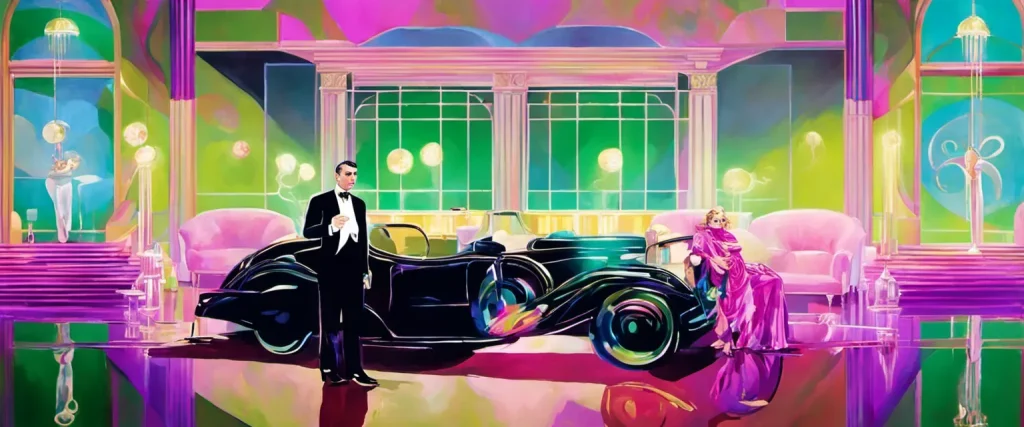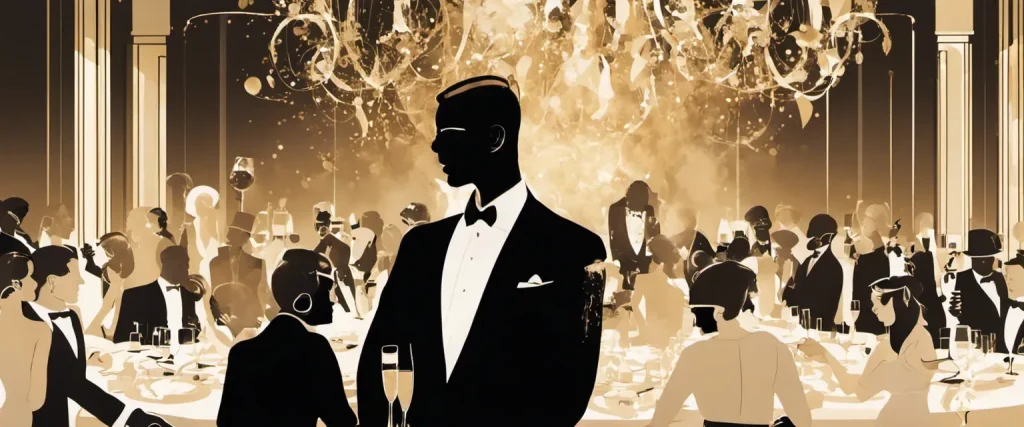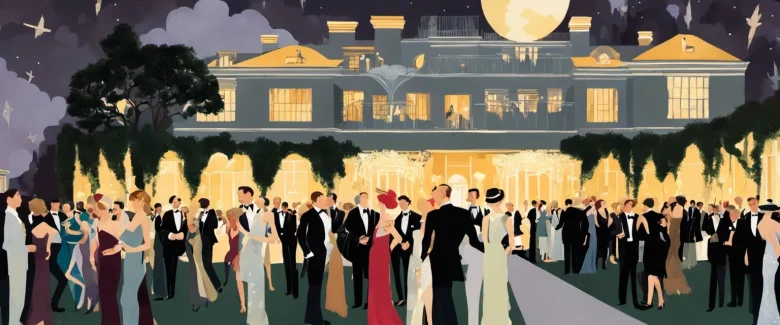In Francis Scott Fitzgerald‘s literary masterpiece, The Great Gatsby, the roaring 1920s come to life in a tale of love, wealth, and the elusive American Dream. Set in the opulent world of Long Island, New York, the story follows the mysterious and charismatic Jay Gatsby as he strives to win back his long-lost love, Daisy Buchanan. Fitzgerald, an iconic American author of the early 20th century, captivates readers with his vivid portrayal of the Jazz Age and explores the darker undercurrents of society during this era of excess and disillusionment.
Chapter 1: Introduction to Long Island’s Elite Society
Chapter 1: Introduction to Long Island’s Elite Society of “The Great Gatsby” by F. Scott Fitzgerald
In the opening chapter of “The Great Gatsby,” author F. Scott Fitzgerald introduces readers to the vibrant and dazzling world of Long Island’s elite society in the 1920s. Set in the fictional town of West Egg, the narrative unfolds through the perspective of Nick Carraway, a young man who has recently moved to New York to pursue a career in bonds.
As the story begins, Nick rents a small house next to a sprawling mansion owned by the wealthy and mysterious Jay Gatsby. Despite the extravagant parties Gatsby throws every weekend, he remains a shadowy figure, captivating the curiosity of his neighbors and the reader alike. Through Nick’s eyes, readers observe the opulence and ostentation that define the lives of the upper class.
The chapter also introduces several other significant characters, including Daisy Buchanan, Nick’s cousin and the object of Gatsby’s affection, and her husband Tom Buchanan, an arrogant and privileged man. The Buchanans represent the established class, with their old money, connections, and social status, while Gatsby represents the nouveau riche, having achieved wealth through questionable means.
The chapter centers on a dinner party attended by Nick, Daisy, Tom, and their friend Jordan Baker, a professional golfer. Here, readers witness the power dynamics at play between these characters. Tom is openly unfaithful to Daisy, carrying on an affair with Myrtle Wilson, a lower-class woman from the “valley of ashes,” a desolate industrial area near Long Island.
Through the juxtaposition of Gatsby’s lavish parties and the stark reality of the Buchanans’ troubled marriage, Fitzgerald explores the themes of wealth, love, and the illusion of the American Dream. This first chapter sets the stage for the compelling and tragic story that unfolds, as it introduces readers to the glittering and yet morally bankrupt society that serves as the backdrop for “The Great Gatsby.”
Chapter 2: The Valley of Ashes
Chapter 2 of “The Great Gatsby” explores the desolate and grim neighborhood known as the Valley of Ashes, situated between the glamour of Manhattan and the affluent East Egg. This barren and decaying area, symbolizing the moral and social decay of the American Dream, serves as a stark contrast to the opulence and wealth displayed by characters like Gatsby and Tom Buchanan.
The chapter begins with Nick Carraway’s description of the Valley of Ashes. It is a desolate landscape stretching between West Egg and New York City, dominated by a giant billboard advertising the eyes of Doctor T.J. Eckleburg. Nick characterizes the area as a “wasteland,” where industrial ash covers everything in a grey pallor and where impoverished workers struggling to make a living toil away in squalor.
Nick’s attention is eventually drawn to a small garage owned by George Wilson, who repairs and sells cars. George is portrayed as a weak and beaten-down man, embodying the dejected spirit of the valley. His wife, Myrtle, seems dissatisfied with her life and seeks escape through an affair with Tom Buchanan, who visits her in the valley.
Nick accompanies Tom on one of his visits to Myrtle’s apartment in the neighborhood. Here, Fitzgerald depicts a raucous party scene, where Myrtle’s sister and friends gather to drink and indulge in hedonistic behavior. This vivid portrayal of excess and debauchery emphasizes the contrasting lifestyles of the rich and the poor.
Throughout this chapter, Fitzgerald establishes the Valley of Ashes as a symbolic representation of the deteriorating American Dream and the social divide that exists in society. The contrast between the glamour of the wealthy and the poverty of the working class highlights the themes of wealth, morality, and disillusionment present throughout the book.
Chapter 3: Extravagance at Gatsby’s Parties
Chapter 3 of The Great Gatsby, titled “Extravagance at Gatsby’s Parties,” showcases the glamorous and lavish nature of Jay Gatsby’s legendary parties. The chapter begins with Nick Carraway’s description of his first invitation to one of Gatsby’s extravagant gatherings, emphasizing their grandeur and the seemingly infinite amount of people in attendance.
As Nick arrives, he is greeted by two women who mistake him for someone else, a common occurrence at these parties where guests come from all walks of life. The scene unfolds to reveal the excessive opulence within Gatsby’s mansion, with rooms filled with people dancing, drinking, and enjoying the festivities. The party atmosphere is further intensified by the live orchestra and chorus filling the air with music.
Nick takes the opportunity to mingle and observe the attendees. He encounters a man named Owl Eyes who is fascinated by Gatsby’s extensive library, but is surprised to find the books are merely empty cardboard cutouts. This observation highlights Gatsby’s penchant for creating illusions and emphasizes his mysterious persona.
Throughout the chapter, Nick also learns more about Gatsby’s vast connections, as guests attempt to introduce themselves and share stories of their encounters with him. However, amidst the extravagant display of wealth and indulgence, Nick finds himself feeling somewhat uneasy and out of place, reflecting on the superficiality and hollowness that often accompanies such decadent parties.
Chapter 3 concludes with Nick witnessing Gatsby alone and isolated in the crowd, hinting at the underlying loneliness and longing that drives Gatsby’s extravagant lifestyle and mysterious allure.
Chapter 4: Unveiling Gatsby’s Past
Chapter 4 of “The Great Gatsby” by F. Scott Fitzgerald explores the mysterious past of the enigmatic Jay Gatsby. The chapter begins with an introduction to Gatsby’s lavish parties and the rumors that circulate about him. Nick Carraway, the narrator, attends one of these parties and engages in a conversation with an individual who claims to have been a classmate of Gatsby’s.
This classmate reveals that Gatsby was born into a humble family in the Midwest and his real name is James Gatz. He came from a farming background and always had aspirations for a bigger and grander life. The young Gatsby had a clear vision of his future and a deep desire to reinvent himself. However, Gatsby’s dreams were not financially feasible, so he sought opportunities elsewhere.
Gatsby left home at seventeen, working for Dan Cody, a copper tycoon, on his yacht. Cody became Gatsby’s mentor, teaching him about the wealthy lifestyle and introducing him to the upper class. Unfortunately, Gatsby’s relationship with Cody ended badly due to his affair with Ella Kaye, a wealthy woman who manipulated Cody’s fortune after his death.
The chapter also explores Gatsby’s connection to Daisy Buchanan, Nick’s cousin. Nick learns about Gatsby’s infatuation with Daisy, revealing that they had a romantic relationship in the past. Gatsby now lives in West Egg, just across the bay from Daisy, and throws extravagant parties in hopes of capturing her attention.
As the chapter concludes, Nick arranges a meeting between Gatsby and Daisy at his house. This sets the stage for further revelations and intensifies the complex web of relationships and secrets in the novel. Overall, Chapter 4 sets the foundation for understanding Gatsby’s past and his grandiose pursuit of wealth and love.
Chapter 5: Reunion with Daisy
In Chapter 5 of “The Great Gatsby” by F. Scott Fitzgerald, Jay Gatsby’s reunion with his long-lost love, Daisy Buchanan, takes center stage. The chapter begins with Gatsby’s nervous anticipation as he prepares to meet Daisy for the first time in years. He obsessively ensures that everything in his extravagant mansion is perfect, perhaps reflecting his desire to recreate the past and make Daisy fall in love with him again.
When Daisy arrives at Gatsby’s mansion with her husband, Tom Buchanan, and her friend Jordan Baker, Gatsby’s excitement mixes with anxiety. Gatsby’s grandiose displays of wealth and luxury are on full display as he shows the women around his mansion. He proudly exhibits his collection of expensive shirts, which captivate Daisy. These shirts symbolize Gatsby’s wealth and how he hopes to impress Daisy with his newfound success.
During tea, Gatsby briefly leaves the room, allowing Tom to question his guest’s background. Unbeknownst to Gatsby, Tom grows suspicious of his affair with Daisy. Gatsby’s past and true identity remain shrouded in mystery.
As the chapter progresses, Daisy becomes increasingly emotional at the sight of Gatsby’s opulent lifestyle and the memory of their past shared moments. The former lovers’ reunion is interrupted by the sound of Gatsby’s piano, which significantly contributes to the already emotionally charged atmosphere. The reunion reaches its peak when Gatsby asks Daisy to say that she never loved Tom. However, Daisy, overwhelmed by the lingering feelings between them, hesitates to fully commit.
By the end of Chapter 5, Fitzgerald highlights the theme of the impossibility of fully recapturing the past. As Gatsby continues to yearn for Daisy’s love and the life they shared before, it becomes evident that their reunion is not as idyllic as Gatsby imagined and that their past connection has been tarnished by the circumstances and their changed selves.

Chapter 6: Gatsby’s Rise and Fall
Chapter 6 of The Great Gatsby by F. Scott Fitzgerald delves into the background and rise of Jay Gatsby, while also exploring the themes of identity, dreams, and the fragility of social status.
The chapter begins with a recounting of Gatsby’s humble origins as James Gatz, born into a poor farming family in North Dakota. Despite his disadvantaged upbringing, Gatsby’s ambition and desire for a better life led him to create a new persona. He reinvented himself as Jay Gatsby, a wealthy and glamorous figure. The narrator, Nick Carraway, describes Gatsby’s determination to become successful, stating that “Gatsby had come a long way to this blue lawn.” Gatsby’s transformation from a poor young man into a successful self-made millionaire represents the American Dream and the idea that anyone can achieve wealth and social standing through hard work.
However, as the chapter progresses, it is revealed that Gatsby’s wealth is not as legitimate as it seems. Rumors begin to circulate that Gatsby acquired his wealth through illegal activities, such as bootlegging and stock-market manipulation. This leads to speculation and gossip surrounding his true identity and the authenticity of his extravagant parties.
The chapter also touches on Gatsby’s undying love for Daisy Buchanan, a motif that has woven throughout the novel. Gatsby’s desire to win Daisy’s love is the driving force behind his seemingly endless pursuit of wealth and social status. Despite his success in acquiring material wealth, Gatsby’s dream of rekindling his relationship with Daisy begins to crumble, putting his rise to power and the fulfillment of his desires at risk.
Overall, Chapter 6 reflects on the complexities of identity and the hollowness of the American Dream. Gatsby’s rise to prominence is contrasted with the corrupt foundations upon which his wealth is built, ultimately foreshadowing his impending downfall.
Chapter 7: Disintegration of Relationships
Chapter 7, titled “The Disintegration of Relationships,” in F. Scott Fitzgerald’s novel The Great Gatsby, marks a turning point in the story as various relationships unravel and tensions escalate.
The chapter commences with Tom Buchanan, Daisy Buchanan’s husband, growing suspicious of his wife’s relationship with Jay Gatsby. As a result, he demands to accompany Daisy to Gatsby’s extravagant mansion for a confrontation. While tensions rise during the encounter, Tom’s mistrust becomes evident when he discovers that Gatsby’s wealth is rooted in illegal activities.
Meanwhile, Gatsby naively believes that Daisy would express her love for him and admit that she never loved Tom. He assumes that Daisy’s marriage is solely based on materialistic considerations. However, Daisy, torn between Tom’s wealth and Gatsby’s love, is unable to make a clear decision.
The chapter illustrates the disintegration of relationships through a heated confrontation between Tom, Gatsby, and Daisy. Ultimately, Daisy’s indecisiveness, coupled with Gatsby’s inability to see the reality of the situation, leads to the deterioration of their romance. Tom skillfully manipulates the situation, using Gatsby’s criminal activities to expose his true nature and push Daisy away from him.
As tensions reach their peak, Daisy decides to leave with Gatsby, driving back to East Egg in her husband’s car. The stage is set for tragedy when Tom, along with Nick Carraway and Jordan Baker, follow them on a separate vehicle. Ultimately, the disintegration of relationships becomes apparent as Gatsby’s aspirations crumble, Daisy retreats back to the comfort of her husband’s wealth, and Tom’s dominance prevails.
In this chapter, Fitzgerald highlights the fragility of relationships, how love can be easily distorted by materialism and deceit, and how ultimately, the allure of wealth and social status can overpower the purest of emotions.

Chapter 8: The Tragic Conclusion
In Chapter 8 of “The Great Gatsby” by F. Scott Fitzgerald, the tragic conclusion of the story unfolds as the characters’ lives unravel. The chapter begins with a description of the aftermath of Gatsby’s death, as newspaper reporters and photographers swarm his mansion. Nick, the narrator, takes charge of Gatsby’s funeral arrangements, but remains disheartened by the lack of genuine mourners.
Nick tries to contact Daisy to inform her about the funeral, but she and Tom have abruptly left town, leaving no forwarding address. Desperate to prevent Gatsby’s funeral from being completely neglected, Nick sets out to find people who knew him. He meets Wolfsheim, Gatsby’s shady business associate, who expresses regret about not attending the funeral but eventually dismisses Gatsby’s death. This encounter further exposes the hollowness of Gatsby’s world.
Attending Gatsby’s funeral are only Nick, Owl Eyes (an eccentric gentleman often seen at Gatsby’s parties), a handful of Gatsby’s servants, and a few journalists. Gatsby’s father, Henry Gatz, also arrives from the Midwest to mourn his son’s death, revealing the magnitude of Gatsby’s fall from grace to his humble family.
After the funeral, Nick returns to Gatsby’s mansion one last time, finding Tom Buchanan there. The two of them have a brief and confrontational conversation, where Tom shows no remorse for his actions, blaming Gatsby for everything that has transpired. Nick realizes the shallow and callous nature of Tom’s character and leaves, never to see him again.
As the chapter concludes, Nick contemplates the emptiness of the American Dream and the tragic fate of those who pursue it relentlessly. He recognizes that Gatsby’s quest for love and acceptance was ultimately in vain, and reflects on the intertwined themes of illusion, disillusionment, and the corrupting influence of wealth and excess that permeate the novel.
After Reading
In conclusion, The Great Gatsby by F. Scott Fitzgerald is a captivating novel that explores the themes of wealth, desire, and the American Dream in the 1920s. Through the mysterious character of Jay Gatsby, Fitzgerald presents a cautionary tale about the emptiness of materialism and the pursuit of illusions. The book delves into the corrupted society of the rich, emphasizing the superficiality of their relationships and the consequences of their reckless behavior. The tragic downfall of Gatsby ultimately serves as a powerful reminder that the American Dream is not attainable through wealth alone, but rather through genuine connection and self-acceptance. Overall, Fitzgerald’s masterpiece offers a profound critique of the decadence and disillusionment that characterized the Jazz Age.
1. One Hundred Years of Solitude” by Gabriel García Márquez
This enchanting masterpiece by García Márquez is a must-read for any lover of literature. Set in the fictional town of Macondo, “One Hundred Years of Solitude” beautifully intertwines elements of magical realism with a captivating multi-generational family saga. The story reveals the complexity of human existence through the lenses of love, war, and the surreal, taking the reader on a breathtaking journey through the Buendía family’s trials and triumphs.
2. Oliver Twist” by Charles Dickens
After delving into the decadence and social dynamics of the Jazz Age in “The Great Gatsby,” Dickens’ classic novel offers a contrasting exploration of Victorian-era England. “Oliver Twist” follows the life of the titular orphan as he navigates the harsh realities of poverty, crime, and exploitation. Dickens’ vivid descriptions, memorable characters, and poignant social commentary make this novel an enduring classic that brilliantly captures the hardships faced by the less fortunate.
3. The Red and the Black” by Stendhal
Similar to “The Great Gatsby,” “The Red and the Black” provides a riveting examination of social ambition, love, and morality. Set in 19th-century France, this novel delves into the life of Julien Sorel, a young man determined to rise above his humble origins. Stendhal’s powerful prose and sharp characterizations offer an incisive critique of social constraints, political aspirations, and the complexities of desire.
4. “One Day in the Life of Ivan Denisovich” by Aleksandr Solzhenitsyn
After immersing yourself in the opulence and carefree lifestyle depicted in “The Great Gatsby,” Solzhenitsyn’s novella offers a starkly contrasting portrayal of life in a Soviet gulag. “One Day in the Life of Ivan Denisovich” follows the titular character, a political prisoner, as he endures the grueling reality of the camp. Solzhenitsyn’s unflinching depiction of the harsh conditions and the human spirit’s resilience in the face of adversity makes this a poignant and thought-provoking read.
5. “Beloved” by Toni Morrison
For readers seeking a powerful exploration of the human psyche and the haunting effects of slavery, “Beloved” is a compelling choice. Morrison presents a gripping tale revolving around the escaped slave Sethe and the manifestation of her repressed trauma, known as Beloved. Seamlessly blending historical realism with elements of the supernatural, this novel delves into the complexity of memory, identity, and the long-lasting repercussions of the past, leaving an indelible impact on its readers.




Comments
Your topic sounds somewhat rushed-you are usually incredibly eloquent in your writing.